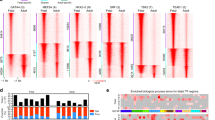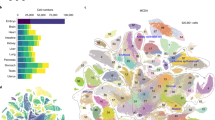Abstract
The E2F family is conserved from Caenorhabditis elegans to mammals, with some family members having transcription activation functions and others having repressor functions1,2. Whereas C. elegans3 and Drosophila melanogaster4,5 have a single E2F activator protein and repressor protein, mammals have at least three activator and five repressor proteins1,2,6. Why such genetic complexity evolved in mammals is not known. To begin to evaluate this genetic complexity, we targeted the inactivation of the entire subset of activators, E2f1, E2f2, E2f3a and E2f3b, singly or in combination in mice. We demonstrate that E2f3a is sufficient to support mouse embryonic and postnatal development. Remarkably, expression of E2f3b or E2f1 from the E2f3a locus (E2f3a3bki or E2f3a1ki , respectively) suppressed all the postnatal phenotypes associated with the inactivation of E2f3a. We conclude that there is significant functional redundancy among activators and that the specific requirement for E2f3a during postnatal development is dictated by regulatory sequences governing its selective spatiotemporal expression and not by its intrinsic protein functions. These findings provide a molecular basis for the observed specificity among E2F activators during development.
This is a preview of subscription content, access via your institution
Access options
Subscribe to this journal
Receive 51 print issues and online access
$199.00 per year
only $3.90 per issue
Buy this article
- Purchase on Springer Link
- Instant access to full article PDF
Prices may be subject to local taxes which are calculated during checkout




Similar content being viewed by others
References
Trimarchi, J. M. & Lees, J. A. Sibling rivalry in the E2F family. Nature Rev. Mol. Cell Biol. 3, 11–20 (2002)
Attwooll, C., Lazzerini Denchi, E. & Helin, K. The E2F family: specific functions and overlapping interests. EMBO J. 23, 4709–4716 (2004)
Ceol, C. J. & Horvitz, H. R. dpl-1 DP and efl-1 E2F act with lin-35 Rb to antagonize Ras signaling in C. elegans vulval development. Mol. Cell 7, 461–473 (2001)
Dynlacht, B. D., Brook, A., Dembski, M., Yenush, L. & Dyson, N. DNA-binding and trans-activation properties of Drosophila E2F and DP proteins. Proc. Natl Acad. Sci. USA 91, 6359–6363 (1994)
Sawado, T. et al. dE2F2, a novel E2F-family transcription factor in Drosophila melanogaster . Biochem. Biophys. Res. Commun. 251, 409–415 (1998)
DeGregori, J. & Johnson, D. G. Distinct and overlapping roles for E2F family members in transcription, proliferation and apoptosis. Curr. Mol. Med. 6, 739–748 (2006)
Helin, K. et al. A cDNA encoding a pRB-binding protein with properties of the transcription factor E2F. Cell 70, 337–350 (1992)
Wu, L. et al. The E2F1–3 transcription factors are essential for cellular proliferation. Nature 414, 457–462 (2001)
Humbert, P. O. et al. E2f3 is critical for normal cellular proliferation. Genes Dev. 14, 690–703 (2000)
Leone, G. et al. Identification of a novel E2F3 product suggests a mechanism for determining specificity of repression by Rb proteins. Mol. Cell. Biol. 20, 3626–3632 (2000)
Li, J. et al. Synergistic function of E2F7 and E2F8 is essential for cell survival and embryonic development. Dev. Cell 14, 62–75 (2008)
Giangrande, P. H. et al. A role for E2F6 in distinguishing G1/S- and G2/M-specific transcription. Genes Dev. 18, 2941–2951 (2004)
Cloud, J. E. et al. Mutant mouse models reveal the relative roles of E2F1 and E2F3 in vivo . Mol. Cell. Biol. 22, 2663–2672 (2002)
Gaubatz, S. et al. E2F4 and E2F5 play an essential role in pocket protein-mediated G1 control. Mol. Cell 6, 729–735 (2000)
Yamasaki, L. et al. Tumor induction and tissue atrophy in mice lacking E2F–1. Cell 85, 537–548 (1996)
Murga, M. et al. Mutation of E2F2 in mice causes enhanced T lymphocyte proliferation, leading to the development of autoimmunity. Immunity 15, 959–970 (2001)
Field, S. J. et al. E2F-1 functions in mice to promote apoptosis and suppress proliferation. Cell 85, 549–561 (1996)
Zhu, J. W. et al. E2F1 and E2F2 determine thresholds for antigen-induced T-cell proliferation and suppress tumorigenesis. Mol. Cell. Biol. 21, 8547–8564 (2001)
Li, F. X., Zhu, J. W., Hogan, C. J. & DeGregori, J. Defective gene expression, S phase progression, and maturation during hematopoiesis in E2F1/E2F2 mutant mice. Mol. Cell. Biol. 23, 3607–3622 (2003)
Opavsky, R. et al. Specific tumor suppressor function for E2F2 in Myc-induced T cell lymphomagenesis. Proc. Natl Acad. Sci. USA 104, 15400–15405 (2007)
Dirlam, A., Spike, B. T. & Macleod, K. F. Deregulated E2f-2 underlies cell cycle and maturation defects in retinoblastoma null erythroblasts. Mol. Cell. Biol. 27, 8713–8728 (2007)
Parisi, T. et al. Selective requirements for E2f3 in the development and tumorigenicity of Rb-deficient chimeric tissues. Mol. Cell. Biol. 27, 2283–2293 (2007)
Blais, A. & Dynlacht, B. D. E2F-associated chromatin modifiers and cell cycle control. Curr. Opin. Cell Biol. 19, 658–662 (2007)
Giangrande, P. H., Hallstrom, T. C., Tunyaplin, C., Calame, K. & Nevins, J. R. Identification of E-box factor TFE3 as a functional partner for the E2F3 transcription factor. Mol. Cell. Biol. 23, 3707–3720 (2003)
Schlisio, S., Halperin, T., Vidal, M. & Nevins, J. R. Interaction of YY1 with E2Fs, mediated by RYBP, provides a mechanism for specificity of E2F function. EMBO J. 21, 5775–5786 (2002)
Jandacek, R. J., Heubi, J. E. & Tso, P. A novel, noninvasive method for the measurement of intestinal fat absorption. Gastroenterology 127, 139–144 (2004)
Acknowledgements
We thank J. Moffitt and L. Rawahneh for histology expertise. We also thank J. Nevins, C. Bock and A. Otoshi for support in the generation of the E2f3a, E2f3b, E2f3a3bki and E2f3a1ki mice, and the Mouse Metabolic Phenotyping center at the University of Cincinnati for advice on the analysis of E2f1-/-E2f3a-/- mice. We are grateful to D. Guttridge, M. Ostrowski and M. Simcox for critically reading the manuscript and helpful suggestions. This work was funded by NIH grants to G.L. (R01CA85619, R01HD042619, R01CA121275, R01HD047470, P01CA097189), to L.W. (K01CA102328), DoD awards to A.d.B. (BC0300893) and J.-L.C. (BC061730), and a T32 fellowship (CA106196) to R.O. G.L. is the recipient of the Pew Charitable Trusts Scholar Award and the Leukemia and Lymphoma Society Scholar Award.
Author information
Authors and Affiliations
Corresponding author
Supplementary information
Supplementary Figures
The file contains Supplementary Figures 1-6 with Legends. (PDF 529 kb)
Rights and permissions
About this article
Cite this article
Tsai, SY., Opavsky, R., Sharma, N. et al. Mouse development with a single E2F activator. Nature 454, 1137–1141 (2008). https://doi.org/10.1038/nature07066
Received:
Accepted:
Published:
Issue Date:
DOI: https://doi.org/10.1038/nature07066
This article is cited by
-
Transcriptomic analysis of granulosa cell populations proximal and distal to the germinal disc of chicken preovulatory follicles
Scientific Reports (2021)
-
DeepCpG: accurate prediction of single-cell DNA methylation states using deep learning
Genome Biology (2017)
-
Determination of the physiological and pathological roles of E2F3 in adult tissues
Scientific Reports (2017)
-
Synergistic functions of E2F7 and E2F8 are critical to suppress stress-induced skin cancer
Oncogene (2017)
-
SNP co-association and network analyses identify E2F3, KDM5A and BACH2 as key regulators of the bovine milk fatty acid profile
Scientific Reports (2017)
Comments
By submitting a comment you agree to abide by our Terms and Community Guidelines. If you find something abusive or that does not comply with our terms or guidelines please flag it as inappropriate.



